Movie? Book?
That looks familiar. But familiar, how?
Movie:
The moment arrives fifteen minutes into Mike Flanagan’s THE LIFE OF CHUCK, adapted from the Stephen King novella collection If It Bleeds.
Marty Anderson (Chiwetel Ejifor), a middle school teacher, in gridlock, par for the course on his afternoon workday commute, looks up at a billboard:

“Charles Krantz: 39 Great Years!
Thanks, Chuck!”
The text is accompanied by a smiling man with black framed glasses in repose at his desk.
A retiring accountant? Banker? Definitely not an athlete, actor, or musician, the usual candidates for overexposure. Either/or, his button-down comportment is straight out of central casting.
On the radio, on television, online and off, the ad seems to be everywhere.
Friends and acquaintances, even total strangers, are equally baffled by the multi-media blitz for this star man (this is a pun, stick a pin in it), but adapt to the extreme cultural shift of what constitutes as being prerequisites for fame as normal.
“We accept the reality of the world which we are presented.”
Life in the 21st century can be both surreal and inevitable, sometimes downright scary.
It can be a show, as Christof (Ed Harris) philosophizes about the prefab reality in Peter Weir’s THE TRUMAN SHOW, starring Jim Carrey.

The world might be ending. But is the apocalypse all in your head, or somebody else’s head?
Marty takes a walk at dusk. Filling every picture window in suburbia, now functioning as a monitor of sorts, as far as Marty and the girl on roller skates can see, Charles Krantz is outlined by blue electric light against the backdrop of our cosmos.
Book:
With Jupiter looming in the background, guitar slung over his shoulder, Buddy Holly asks for Ed Sullivan’s whereabouts in the television set of Oliver Vale. The pirate transmission interrupts regular scheduled programming. Oliver was expecting THE SEARCHERS. Oliver grabs a flashlight. Something screwy with the satellite dish.
It’s a very obscure book. It’s in the public domain.
There is a Wikipedia entry. The occasional book review from genre fiction specialty sites.

Photos of the novelist. He has a modest online presence.
Cory Doctorow is a fan.
The author is definitely not Stephen King writing under a second alias.
Buddy Holly Is Alive And Well On Ganymede, a comic sci-fi novel is by cult writer Bradley Denton.
It could’ve been a contender.

The 1991 book was announced as a feature film with Jared Hess (NAPOLEON DYNAMITE) to star as Oliver Vale, the son of a rock and roll-obsessed mother whose satellite dish picks up an intergalactic frequency that showcases a newly reanimated Lubbock native, immortalized by Don McLean in song.

The body among bodies found in an Iowa cornfield on Feburary 3, 1959 identified as Charles Hardin Holley.
This common first name, ‘Charles’ to me, was intended as an entry point that links the Denton novel to THE LIFE OF CHUCK:
Whose first act ends on a decided apocalyptic note, in actuality, turns out to be a dying man’s adaptation of contemporary life, a nightmarish dreamscape that updates Victorian literature and pays homage to the use of futurism in movies.
AND SING TO ME LOVE’S STORY
AND BRING TO ME LOVE’S GLORY
Oliver Vale was conceived in the front seat of a 1955 four-door Chevrolet while “Heartbeat”(#82) played over the radio, obscuring sounds that told love’s story. “Piddly dee pat,” and that was that.
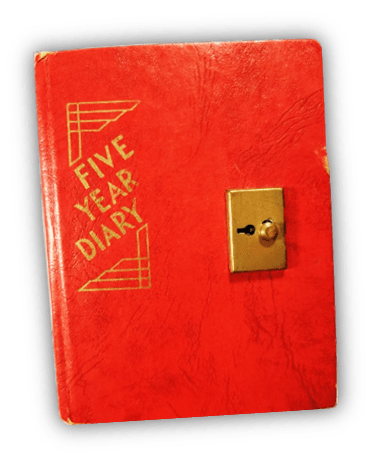
His mother had kept a diary.
The beat goes on in THE LIFE OF CHUCK.
This time, it’s a heartbreak beat. “BIP…BIP…BIP…,” the monitor registers a steady 75 before the “Heartbeat” stops, flatlines, and unceremoniously falls off the medical chart. Felicia Gordon (Karen Gillan), Marty’s ex-wife, functions as a linchpin that integrates both worlds of the film, the diegetic(the world of the movie) and extra-diegetic(the world of the novel or novels).
Over the phone, Marty explains the cosmic calendar, breaking down the history of the universe into numbers.

She jokes: “I was told there would be no math.”
Felicia’s words activate the latency of intertextuality, a surfacing, in which 75 is not just a number, but a number you arrive at.
Stephen King writes genre fiction erudition into the nurse’s backstory, or rather, her performative subconscious.
75: Charles Krantz’s heart rate at the moment of his passing, appears in every empty room with the same malfunctioning heart monitor:

A haunted clinic that reveals itself to be the invention of an intelligence not native to the mis-en-scene.
Felicia naively orientates the audience. YOU find the hidden math. YOU carry the one. It’s extra-diegetic numerology, just a simple arithmetic problem; not the unified field theory.
36 (the year Buddy Holly was born)
+ 39 (the age of Charles Krantz’s passing)
———————————————–
= 75 (heartbeats).
A number that just so happens to be the minimum score you need to become a CPA.
“Some people think we’re living in the end times,” Felicia confides to her ex. “It’s not just the religious crazies either…” Marty, an evergreen optimist, probably wants the conversation to end.
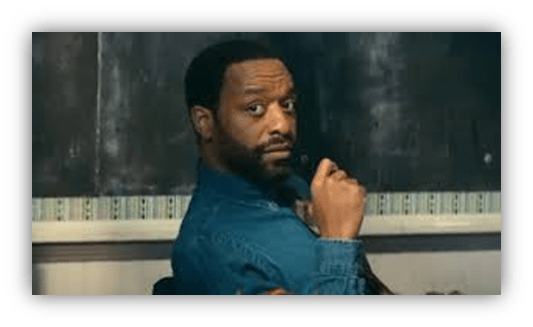
At work, especially during the parent-teacher conference sequence, his business as usual demeanor is met with bewilderment by all the pessimists.
“…not anymore,” Felicia adds, in which she means that the evidence is less emotional than empirical. The weather can be a theater of cruelty. What happened to science?
What happened to all the drive in theaters?
The SkyVue is where Oliver Vale and his friends battle an old school minister and his cult who believe rock and roll is the devil’s music that can destroy the planet. Nobody dies when a fifty foot Buddy Holly, live from Jupiter, performs “Rave On”. In reality, the earth’s rotation is slowing down.
ON SUNDAY, JULY 20TH, NEIL ARMSTRONG STEPPED ON THE SURFACE OF THE MOON. I BOUNCED AROUND THE APARTMENT TRYING TO DUPLICATE THE MOON WALK.
– Oliver Vale
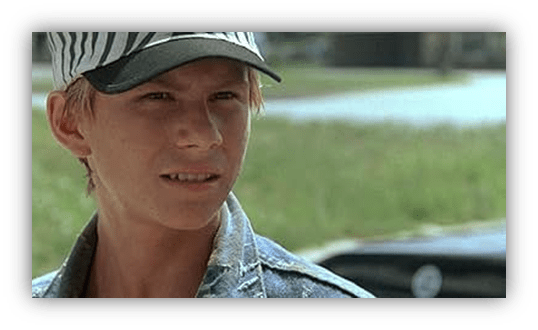
“I’M ALRIGHT.“
– Christian Slater as Binx in THE LEGEND OF BILLIE JEAN
As a preteen, Charles Krantz (Benjamin Pajak) amazes Miss Rohrbacher (Samantha Sloyan) and the other Twirlers and Spinners, an after school club, with his ability to moonwalk. The dance instructor says: “Show me,” as if Michael Jackson never existed.
For the record, “Billie Jean” didn’t survive the transition from book to film. “My Sharona” bounces off the gymnasium walls, instead.
Chuck’s formative years were spent in his Bubbie’s kitchen, learning to dance.
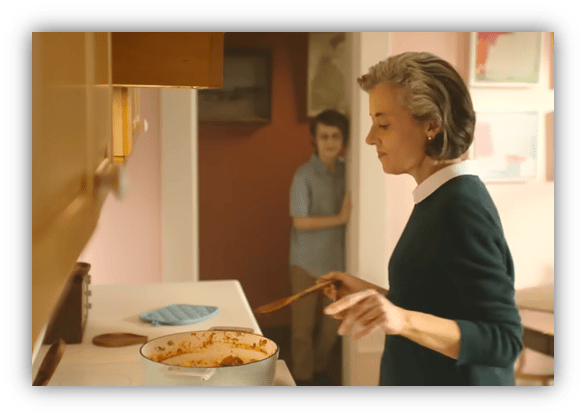
Sarah Krantz (Mia Sara) liked Wang Chung. The presence of “Dance Hall Days” has an alternate universe quality in the Danny Boyle vein (EVERYDAY instead of YESTERDAY) since “grandma liked rock and roll,” the narrator (Nick Offerman) informs us, but it makes extra-diegetic sense for the world of BUDDY HOLLY IS ALIVE AND WELL IN GANYMEDE.
Oliver Vale’s record collection “suffers from a paucity of Motown” according to Sharon, his psychiatrist. It’s a two-way mixed media wormhole.

The London-based synth-pop band’s debut album Points On The Curve peaked at #59 after being released in February 1984.
As it so happens, this seemingly idiosyncratic scoring choice aligns perfectly with the historicity of Felicia’s magic numbers.
Buddy Holly’s plane went down in Clear Lake, Iowa on February 3, 1959. YOU find the hidden math, again. YOU carry the one, again. The moonwalk still belongs to Neil Armstrong.
The kids standing around in wonder on the basketball court have no frame of reference when they witness this sublime feat of feet in motion. To them, Charles Krantz invented Michael Jackson’s signature move.
More math:
1984 (Jack Hues is the King of Pop)
– 1959 (Buddy Holly dies in a plane crash.)
———————————————————–
= 25 (as in MOTOWN’S 25).
A groove is a rhythm pattern. For now, for awhile, the groove eludes this young woman, a recent Juilliard dropout.
Taylor (Taylor Gordon) ekes out a living playing the drums for hat money.

But then, like a meet cute in a musical, art imitating life, she sees Chuck approaching.
A groove is a rhythm pattern, a heartbeat. We don’t have another post-1959 Lubbock situation on our hands. Grave robbers from outer space didn’t desecrate Charles Krantz’s grave. He’s not a zombie; he’s alive.
That’s because THE LIFE OF CHUCK unfolds in reverse chronological order like BETRAYAL, a play by Harold Pinter.
The busker makes her drum go piddly-pat. Chuck plowed through a lot of Blockbuster rentals with his grandmother, musical upon musical on VHS, including SWING TIME starring Fred Astaire. It all comes back to him, the language of hoofing.
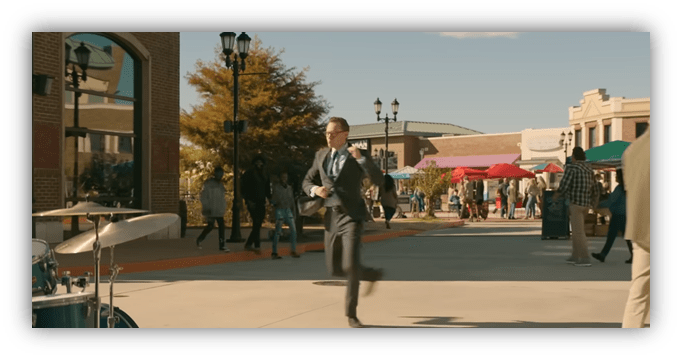
He puts down his briefcase. And moves to the beat, a syncopated heartbeat, the groove.
He picks out his Ginger Rogers from the gathering lunch crowd. “C’mon, little sister, let’s dance,” sounding less like Fred than MJ, disguised as “The King of Spreadsheets” asking Janet to “Scream”. It’s SCREAM TIME. Chuck moonwalks, not so far from a restaurant called El Dorado(same townname as the SkyVue), a Spanish word that means “golden” to Puerto Ricans. Maria Elena Santiago, Buddy Holly’s widow, as it so happens, was born in San Juan.
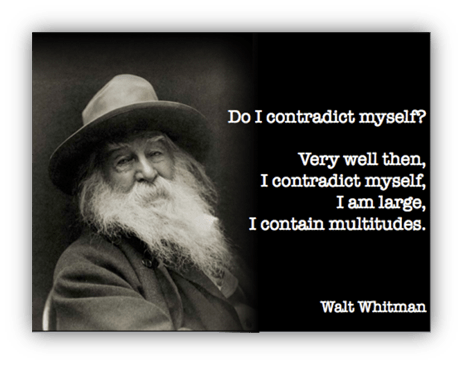
I AM LARGE. I CONTAIN MULTITUDES.
-Walt Whitman
On the last day of school, nobody is listening to the English teacher read from LEAVES OF GRASS, a poetry collection by Walt Whitman, except for Charles Krantz, future accountant.
On the last day of earth, as it becomes clear that breathing can no longer be taken for granted, with his wife and son keeping vigil in a private room,
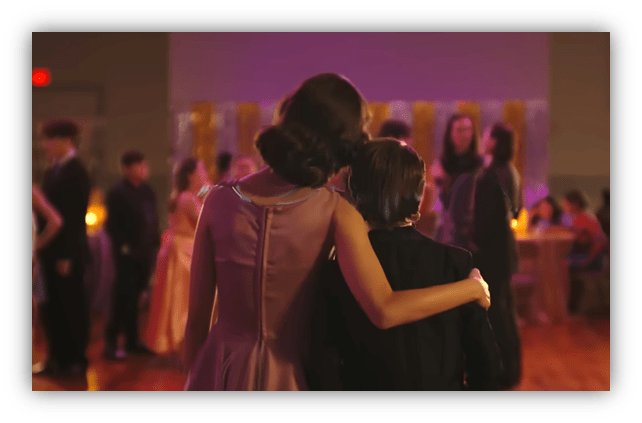
Chuck remembers the night he and Cat McCoy (Trinity Bliss) danced up a storm in their middle school gymnasium to The Spencer Davis Group.
“Gimme Some Lovin'” is his SONG OF MYSELF. Published in 1855, free verse killed the Petrachan sonnet, one of the forms favored by Victorian poets. The song is a recollection that gets programmed into Marty Anderson’s car radio. It’s a post-modern world steeped in transcendentalism that Chuck created from ear to ear.
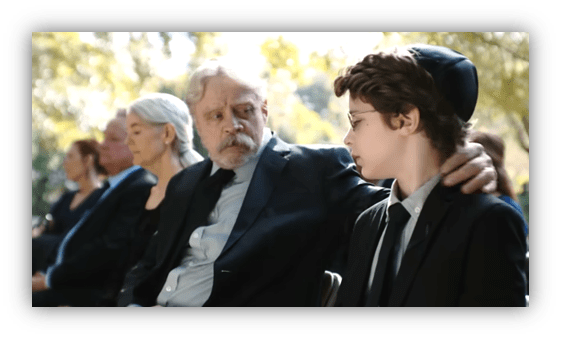
Albe Krantz (Mark Hamill), his Zaydee, made it a point of emphasis that their house was “real Victorian”, not pretend.
The cupola, a small room Albie described as being “full of ghosts” was where he previewed his death and the death of others. Chuck’s grandfather didn’t quite have the vocabulary They weren’t quite dead yet, “ghosts”, the people in his visions. This simulacrum becomes a part of Charles Krantz’s inheritance.
Grandpa wouldn’t lie, but the late Albe Krantz drank a lot.
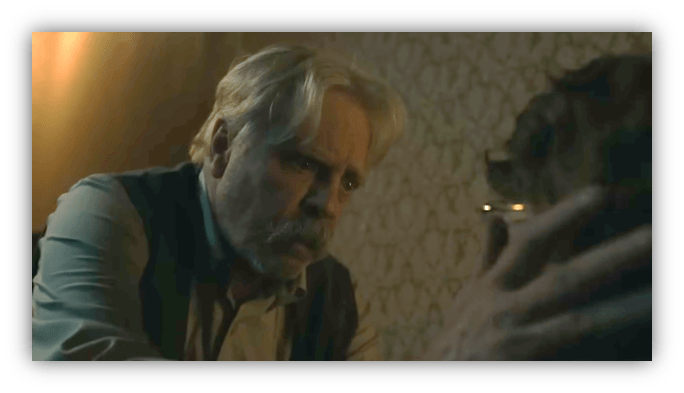
And Chuck was just a kid, naive and impressionable. Older now, a young adult (Jason Trembly), the new homeowner can’t help but turn the cupola key.
The discovery of seeing himself, his future self, is staged, arguably, to look like the Star Baby sequence from 2001: A SPACE ODYSSEY, directed by Stanley Kubrick.
Jupiter orbits a moon. It must be Ganymede. (Say HI to Buddy.)

Bowman (Keir Dullea), the mission commander, gets into a pod.
The EVA gets pulled into a vortex of lights and landscapes, which ends up in 19th century digs, assembled by aliens with a taste for the neoclassical. The secretary desk and armchairs look like real Victorian furniture, not pretend.
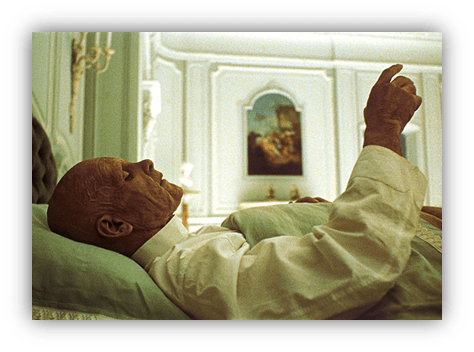
Bowman, suddenly older from the man who piloted the Discovery One, looks back at himself lying down in a bed large enough for an elephant.
In the next shot, a monolith towers at the foot. Bowman metamorphoses into a bubble-shaped womb.
In THE LIFE OF CHUCK, the movie captures one dramatic leap in age (young adult to adult)
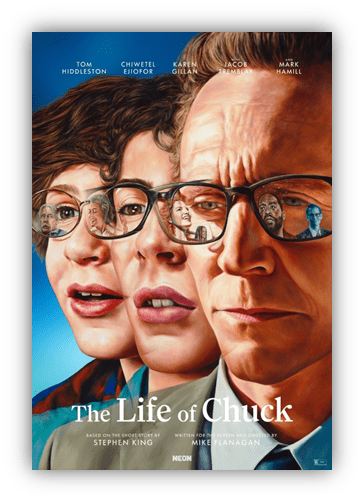
Whereas the movie poster captures two (child to young adult to adult), like the astronaut in flux.
The cupola doorway is rectangular like the monolith. If the dying man follows the same trajectory as the fetus, he’d be on the other side, the alternate world he adapted from the Walt Whitman poem, represented by horizontal monoliths(a billboard, a picture window). The Star Baby hovers in space overlooking earth.

Conversely, Charles Krantz, a gentle soul, surely, can’t possibly be responsible for the annihilation of his own personal universe.
AI: Felicia?
FELICIA: IT’S AI.
More math: HAL can recite “Daisy Bell”, an 1892 song written by Henry Dacre, which features the lyric: “a bicycle built for:
2
+ 2 (“Peggy Sue”, an Ariel Cyclone – a motorcycle built for two)
= “Billie Jean”, (the song that appears in the Stephen King novella, and inspired, perhaps, by Binx’s Honda Elite scooter in the 1985 film THE LEGEND OF BILLIE JEAN, directed by Matthew Robbins
——————————————-
= Christian Slater: “It’s alright.”
Which references the “Happiness” B-side, “Well…Alright”.
AI: Felicia, c’mon.
FELICIA: Isn’t a daisy chain linear math?
Besides, the next novella in If It Bleeds is the titular novella, featuring a character named Holly, and…wait, who am I talking to? You’re making me say stupid stuff. You’re the universe killer!
AI: There is no author! There is no author! Roland Barthes was right! The narrator, not Stephen King decided to end humanity.




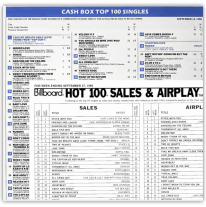

I was told there would be no math.
This is a dense piece but I think I get the point. If it’s told backwards, it must be Chuck looking back on his life, a sort of how-did-I-get-here story, right? That’s something we should all do from time to time. If the movie gets us to think about it, it’s probably worth seeing.
Cappie, what would you give it on a scale of 10?
9.
LOL. You’re forcing me to be Pauline Kael. I’m on team Sarris.
I liked it a lot.
There. That’s the first opinion I ever gave on a movie.
Mia Sara and Mark Hamill as a married couple? Are you not potentially entertained? Because of Hamill’s participation, I kept a lookout for anything that could possibly resemble a reference to a science fiction film. What I came up with is convoluted. I started at a place of satire, but the more I thought about it, I convinced myself that the reference is actually there.
(I read a funny story about Mia Sara’s children being embarrassed by their mother because she was retired. Their friends had parents who were active in the biz.)
This film was underpromoted. I saw the trauma-inducing trailer for The Long Walk like every time I saw Hurry Up Tomorrow. By the third time, I shut my eyes and clamped both hands to my ears. I think they moved up the theatrical release date.
Wang Chung’s “Dance Hall Days”? That was such a weird musical choice, I repeatedly looked at the film from different entry points.
And the answer to the first question: Yes.
So The Life Of Chuck isn’t a biopic of our own esteemed contributor?
Intriguing take, there’s a lot going on.
I thought the name Mike Flanagan was familiar. Realisation he’s the one man Netflix horror production line. I haven’t seen any of his films but I’ve seen all of his Netflix shows. They range from annoying to ludicrous to annoyingly ludicrous to entertaining to entertainingly ludicrous. Even when bad they’re watchable.
Sounds like this is a more ambitious project. If only I had more time to see all these films.
Glad to hear Buddy Holly is alive and well on Ganymede. Again, a more ambitious take than Elvis is alive and well and living on the moon.
Buddy Holly is featured in two Stephen King short stories. The one I read was You Know They Got One Hell of a Band.
Mike Flanagan has pulled off a couple really good King adaptations in film (“Gerald’s Game” and Doctor Sleep”).
“Sleep” is an especially good adaptation as it pulls some cool tricks so it can act as a sequel to both the book and Kubrick film of “The Shining”.
I have been of two minds about seeing this one. I’m a bit leery about films based on King’s writings. There have been some really good translations and some truly horrific ones. On the plus side, Tom Hiddleston is one of my favorite actors. On the other, the story was not one of my favorites. It seems that it would be nearly impossible to totally capture on film.
I’m looking forward to Holly.
That was my introduction to Holly. I enjoyed The Bill Hodges trilogy. The short story in If It Bleeds kind of bored me. The Outsider is almost as good as Holly.
I kind of wish I didn’t see Mr. Mercedes series. I prefer the movie in my head. The filmmaker made Brady too sympathetic. Not all murderers have to be complex. Can’t they simply be evil incarnate?
I guess I have zero excuse for not watching this film. 🙂
Thanks for providing me a good reason, cappie.
Believe me, I was self-conscious about writing this up. It was either this or bum everybody out with a Saturday Night Fever/Pablo Larrain’s Pinochet Trilogy essay. I rewatched Tony Manero. It’s a lot bleaker than I remember. I’m amazed that Barry Gibb gave Larrain permission to use “You Should Be Dancing”.
I didn’t want to read the article until I had watched the film. My wife and I finally did so tonight. It hit hard with both of us and I am still processing. Splitting it into 3 acts and running them in reverse on paper doesn’t look like a good idea, but it totally works. You just have to hang with it and it makes total sense. Thank you for writing about this movie. I don’t know if I would have watched it otherwise.